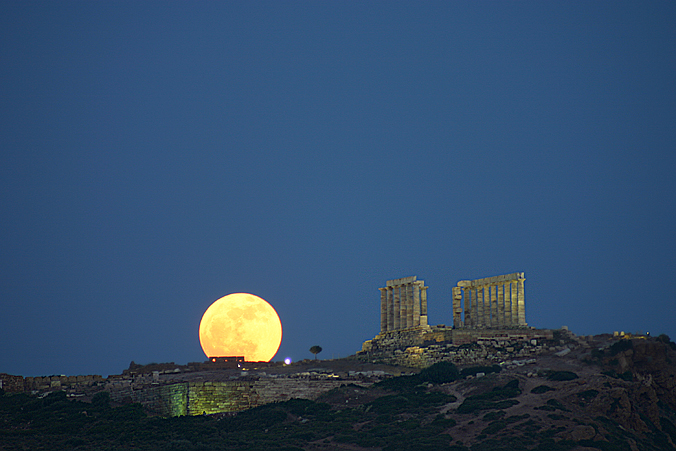Deze avond zal de volle maan een bijzondere truc uithalen: ze zal buitengewoon groot en laaghangend verschijnen. Een lage maanstand zorgt voor een zogenaamde 'maan-illusie'; de maan lijkt groter naarmate ze dichter bij de horizon wordt waargenomen. Vandaag verschijnt de volle maan op het laagste punt sinds juni 1987.
De reden voor de 'show' ligt deels in het feit dat gisteren de zomer begon; dan bereikt de zon het hoogste punt terwijl de maan 's zomers juist het laagst staat. Daarnaast valt het begin van de zomer dit jaar samen met een bepaald punt van een 18,6-jarige cyclus van 'scheve' omwentelingen rond de aarde, waardoor de maan nog lager dan normaal verschijnt.
Bij redelijk vrij zicht op de zuidelijke horizon moet de ongewoon grote maan goed te zien zijn. Het effect is het sterkst in het noorden. De maan komt vanavond om ongeveer 23:20 op.
N.B. De maan staat natuurlijk nog lager aan de hemel bij maansopkomst en -ondergang, dan is de maanillusie het sterkst. Maar het bijzondere van vandaag is dat het hoogste punt dat de volle maan in de loop van de nacht bereikt zeldzaam laag is.
Grote volle maan vanavond
Moderators: Michel Uphoff, jkien
-
Comm
- Artikelen: 0
- Berichten: 128
- Lid geworden op: ma 23 mei 2005, 18:09
-
dreamz
- Artikelen: 0
- Berichten: 108
- Lid geworden op: ma 30 aug 2004, 12:19
Re: Grote volle maan vanavond
en waaraan is dit te wijten?
-ik weet niet zoveel van de maan, zover ik weet draait de maan ik rustig rond de aarde en zien we ze elke dag en wordt ze groter en kleiner naarmate de hoek tov de zon-
-ik weet niet zoveel van de maan, zover ik weet draait de maan ik rustig rond de aarde en zien we ze elke dag en wordt ze groter en kleiner naarmate de hoek tov de zon-
-
Rifleman
- Artikelen: 0
- Berichten: 187
- Lid geworden op: zo 12 jun 2005, 01:04
Re: Grote volle maan vanavond
gewoonweg de baan van de maan... is rond deze tijd altijd zo laag (misschien andere kant van de aarde, maar iig op dezelfde 'hoogte').
even nagekeken met de astronomische software

even nagekeken met de astronomische software
-
Comm
- Artikelen: 0
- Berichten: 128
- Lid geworden op: ma 23 mei 2005, 18:09
Re: Grote volle maan vanavond
Lees hier meer over de zomermaan illusie
-
jelix
- Artikelen: 0
- Berichten: 46
- Lid geworden op: ma 02 aug 2004, 14:46
Re: Grote volle maan vanavond
Hier volgen nog een paar pics:






-
peterA
- Artikelen: 0
- Berichten: 672
- Lid geworden op: za 11 jun 2005, 15:53
Re: Grote volle maan vanavond
Summer Moon Illusion
The lowest-hanging full moon in 18 years is going to play tricks on you this week.
June 20, 2005: Sometimes you can't believe your eyes. This week is one of those times.
Step outside any evening at sunset and look around. You'll see a giant moon rising in the east. It looks like Earth's moon, round and cratered; the Man in the Moon is in his usual place. But something's wrong. This full moon is strangely inflated. It's huge!
You've just experienced the Moon Illusion.
Sky watchers have known this for thousands of years: moons hanging low in the sky look unnaturally big. Cameras don't see it, but our eyes do. It's a real illusion.
This week's full moon hangs lower in the sky than any full moon since June 1987, so the Moon Illusion is going to be extra strong.
What makes the moon so low? It's summer. Remember, the sun and the full Moon are on opposite sides of the sky. During summer the sun is high, which means the full moon must be low. This week’s full moon occurs on June 22nd, barely a day after the summer solstice on June 21st--perfect timing for the Moon Illusion.
When you look at the moon, rays of moonlight converge and form an image about 0.15 mm wide in the back of your eye. High moons and low moons make the same sized spot. So why does your brain think one is bigger than the other? After all these years, scientists still aren't sure why.
A similar illusion was discovered in 1913 by Mario Ponzo, who drew two identical bars across a pair of converging lines, like the railroad tracks
The distant line seems to be longer.
Some researchers believe that the Moon Illusion is Ponzo's Illusion, with trees and houses playing the role of Ponzo's converging lines. Foreground objects trick your brain into thinking the moon is bigger than it really is.
But there's a problem. Airline pilots flying at very high altitudes sometimes experience the Moon Illusion without any objects in the foreground. What tricks their eyes?
Maybe it's the shape of the sky. Humans perceive the sky as a flattened dome, with the zenith nearby and the horizon far away. It makes sense: Birds flying overhead are closer than birds on the horizon. When the moon is near the horizon, your brain, trained by watching birds, miscalculates the moon's true distance and size.
It doesn't matter which is correct, though, if all you want to do is see a big beautiful moon. The best time to look is around moonrise, when the moon is peeking through trees and houses or over mountain ridges, doing its best to trick you.
A fun activity: Look at the moon directly and then through a narrow opening of some kind. For example, 'pinch' the moon between your thumb and forefinger or view it through a cardboard tube, which hides the foreground terrain. Can you make the optical illusion vanish?
Stop that! You won't want to miss the Moon Illusion.
http://science.nasa.gov/headlines/y2005/20...oonillusion.htm
The lowest-hanging full moon in 18 years is going to play tricks on you this week.
June 20, 2005: Sometimes you can't believe your eyes. This week is one of those times.
Step outside any evening at sunset and look around. You'll see a giant moon rising in the east. It looks like Earth's moon, round and cratered; the Man in the Moon is in his usual place. But something's wrong. This full moon is strangely inflated. It's huge!
You've just experienced the Moon Illusion.
Sky watchers have known this for thousands of years: moons hanging low in the sky look unnaturally big. Cameras don't see it, but our eyes do. It's a real illusion.
This week's full moon hangs lower in the sky than any full moon since June 1987, so the Moon Illusion is going to be extra strong.
What makes the moon so low? It's summer. Remember, the sun and the full Moon are on opposite sides of the sky. During summer the sun is high, which means the full moon must be low. This week’s full moon occurs on June 22nd, barely a day after the summer solstice on June 21st--perfect timing for the Moon Illusion.
When you look at the moon, rays of moonlight converge and form an image about 0.15 mm wide in the back of your eye. High moons and low moons make the same sized spot. So why does your brain think one is bigger than the other? After all these years, scientists still aren't sure why.
A similar illusion was discovered in 1913 by Mario Ponzo, who drew two identical bars across a pair of converging lines, like the railroad tracks
The distant line seems to be longer.
Some researchers believe that the Moon Illusion is Ponzo's Illusion, with trees and houses playing the role of Ponzo's converging lines. Foreground objects trick your brain into thinking the moon is bigger than it really is.
But there's a problem. Airline pilots flying at very high altitudes sometimes experience the Moon Illusion without any objects in the foreground. What tricks their eyes?
Maybe it's the shape of the sky. Humans perceive the sky as a flattened dome, with the zenith nearby and the horizon far away. It makes sense: Birds flying overhead are closer than birds on the horizon. When the moon is near the horizon, your brain, trained by watching birds, miscalculates the moon's true distance and size.
It doesn't matter which is correct, though, if all you want to do is see a big beautiful moon. The best time to look is around moonrise, when the moon is peeking through trees and houses or over mountain ridges, doing its best to trick you.
A fun activity: Look at the moon directly and then through a narrow opening of some kind. For example, 'pinch' the moon between your thumb and forefinger or view it through a cardboard tube, which hides the foreground terrain. Can you make the optical illusion vanish?
Stop that! You won't want to miss the Moon Illusion.
http://science.nasa.gov/headlines/y2005/20...oonillusion.htm
huh?
-
umpf
- Artikelen: 0
- Berichten: 18
- Lid geworden op: di 21 jun 2005, 15:27
Re: Grote volle maan vanavond
zo zag ie er uit in Griekenland boven de tempel van Poseidon

Deze foto is van ...
Credit & Copyright: Anthony Ayiomamitis

Deze foto is van ...
Credit & Copyright: Anthony Ayiomamitis
-
Yggdrasil
- Artikelen: 0
Re: Grote volle maan vanavond
Jeetje... echt prachtig.
Ik heb altijd iets met de maan gehad. IK vind 'r zo mooi. Ik kan ook uren naar d'r kijken. (of was de maan nou mannelijk???)
Ik streep in m'n agenda aan het begin van het jaar altijd gelijk alle volle manen van het komende jaar aan en kijk er dan elke maand (soms dan 2x in de maand) even naar. Nieuwe maan vind ik ook wel tof. Helemaal "weg". ^^
Ik zelf wel 's zo'n ring om de maan gezien. Dat was ook echt super mooi. M'n broer en ik kgingen toen op Google opzoeken wat het was en toen bleken er dus heel veel info en foto's over te vinden. Ecnt super cool.
Ik heb altijd iets met de maan gehad. IK vind 'r zo mooi. Ik kan ook uren naar d'r kijken. (of was de maan nou mannelijk???)
Ik streep in m'n agenda aan het begin van het jaar altijd gelijk alle volle manen van het komende jaar aan en kijk er dan elke maand (soms dan 2x in de maand) even naar. Nieuwe maan vind ik ook wel tof. Helemaal "weg". ^^
Ik zelf wel 's zo'n ring om de maan gezien. Dat was ook echt super mooi. M'n broer en ik kgingen toen op Google opzoeken wat het was en toen bleken er dus heel veel info en foto's over te vinden. Ecnt super cool.